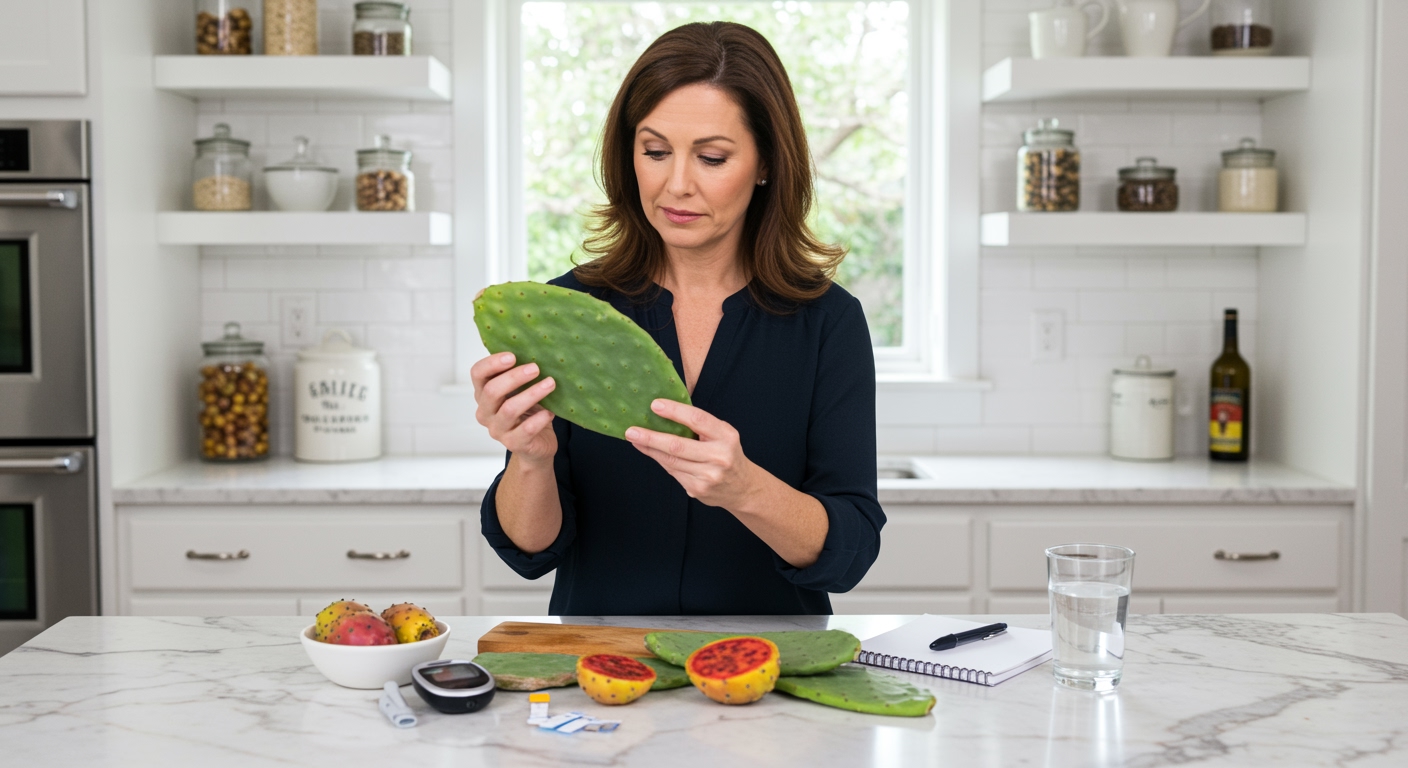✪ Key Takeaway: Cactus can help lower blood sugar levels in people with diabetes through natural compounds that slow glucose absorption.
Introduction
Your grandmother might have been right about that weird cactus remedy she always talked about.
You are probably asking this question because you have heard whispers about cactus helping with blood sugar control, or maybe your doctor mentioned exploring natural options alongside your current diabetes management plan.
Hi, I am Abdur, your nutrition coach and today I am going to explain exactly how cactus affects diabetes and whether this prickly plant deserves a place in your health routine.
What Type Of Cactus Helps With Diabetes?
The prickly pear cactus is the specific type that shows promise for diabetes management.
This cactus goes by the scientific name Opuntia and grows throughout Mexico, the southwestern United States, and parts of South America.
People eat both the pads (called nopales) and the fruits (called tunas) of this cactus.
The pads contain the highest concentration of beneficial compounds for blood sugar control.
These compounds include pectin, mucilage, and various antioxidants that work together to influence how your body processes glucose.
You can find prickly pear cactus in Mexican grocery stores, health food stores, or even growing wild in desert regions.
✪ Pro Tip: Always remove the spines and glochids completely before consuming any part of the prickly pear cactus.
How Does Cactus Lower Blood Sugar Levels?
Cactus works through multiple mechanisms to help control your blood glucose levels.
The high fiber content in cactus pads slows down the absorption of sugar from your digestive tract into your bloodstream.
This means your blood sugar rises more gradually after meals instead of spiking rapidly.
The mucilage in cactus forms a gel-like substance in your stomach that further delays glucose absorption.
Some studies suggest that cactus may also improve insulin sensitivity, helping your cells respond better to the insulin your body produces.
The antioxidants in cactus, particularly betalains, may protect your pancreatic cells from damage caused by high blood sugar levels.
This protection could help preserve your body’s natural ability to produce insulin over time.
✪ Fact: Cactus can reduce post-meal blood sugar spikes by up to 48% according to some research studies.
What Does The Research Say About Cactus And Diabetes?
Multiple clinical studies have examined the effects of prickly pear cactus on blood sugar control.
A study published in the journal Diabetes Care found that people with type 2 diabetes who consumed cactus pads before meals experienced significant reductions in their post-meal glucose levels.
Another research study showed that regular consumption of cactus extract helped lower hemoglobin A1C levels, which measure average blood sugar over three months.
The studies typically used doses ranging from 100 to 500 grams of fresh cactus pads or equivalent amounts of cactus extract.
Most research participants experienced benefits within 30 to 60 minutes after consuming cactus, with effects lasting several hours.
However, researchers note that cactus should complement, not replace, conventional diabetes medications and lifestyle changes.
✪ Note: Most studies on cactus and diabetes have been small-scale, so more research is needed to confirm long-term benefits.
How Should You Use Cactus For Diabetes Management?
The most effective way to use cactus for diabetes is to consume the fresh pads about 30 minutes before meals.
Start with small amounts, around 100 grams of fresh cactus pad, to see how your body responds.
You can prepare cactus pads by grilling, sautéing, or adding them raw to salads and smoothies.
The taste is mild and slightly tart, similar to green beans with a hint of lemon.
If fresh cactus is not available, you can find cactus supplements in capsule or powder form at health stores.
Always monitor your blood sugar levels closely when adding cactus to your routine, especially if you take diabetes medications.
Some people experience mild digestive upset when first introducing cactus, so start slowly and increase gradually.
✪ Pro Tip: Combine cactus with protein and healthy fats for even better blood sugar control throughout the day.
Are There Any Risks Or Side Effects?
Cactus is generally safe for most people when consumed in food amounts.
The most common side effects include mild stomach upset, diarrhea, or nausea, especially when you first start eating it.
People taking diabetes medications should be particularly careful because cactus can enhance the blood sugar-lowering effects of these drugs.
This combination could potentially cause your blood sugar to drop too low, leading to hypoglycemia.
If you take insulin or other diabetes medications, work with your healthcare provider to monitor your blood sugar levels closely when adding cactus.
Some people may be allergic to cactus, so start with very small amounts to test your tolerance.
Pregnant and breastfeeding women should avoid cactus supplements, though small amounts of fresh cactus in food are likely safe.
✪ Note: Always consult your doctor before adding cactus to your diabetes management plan, especially if you take medications.
The Bottom Line
Cactus, particularly prickly pear, shows genuine promise as a natural tool for helping manage blood sugar levels in people with diabetes.
Nature often provides the simplest solutions to our most complex health challenges, but wisdom lies in using these gifts alongside modern medicine, not instead of it.
I would love to hear about your experiences with cactus or any questions you might have about incorporating natural approaches into your diabetes management plan, so please share your thoughts in the comments below.
References
At NutritionCrown, we use quality and credible sources to ensure our content is accurate and trustworthy. Below are the sources referenced in creating this article:
- Rupa Health: Prickly Pear Cactus for Diabetes: The Evidence Behind This Powerful Plant
- WebMD: Prickly Pear Cactus Uses and Risks
- MDPI: Prickly Pear Cactus and Diabetes Research
- Clemson University: Prickly Pear and Diabetes





